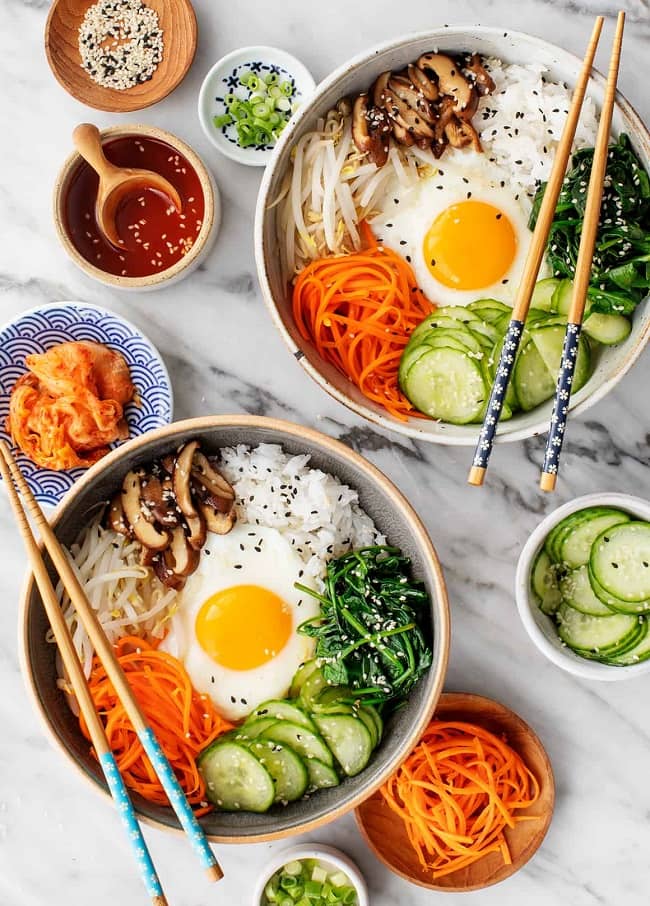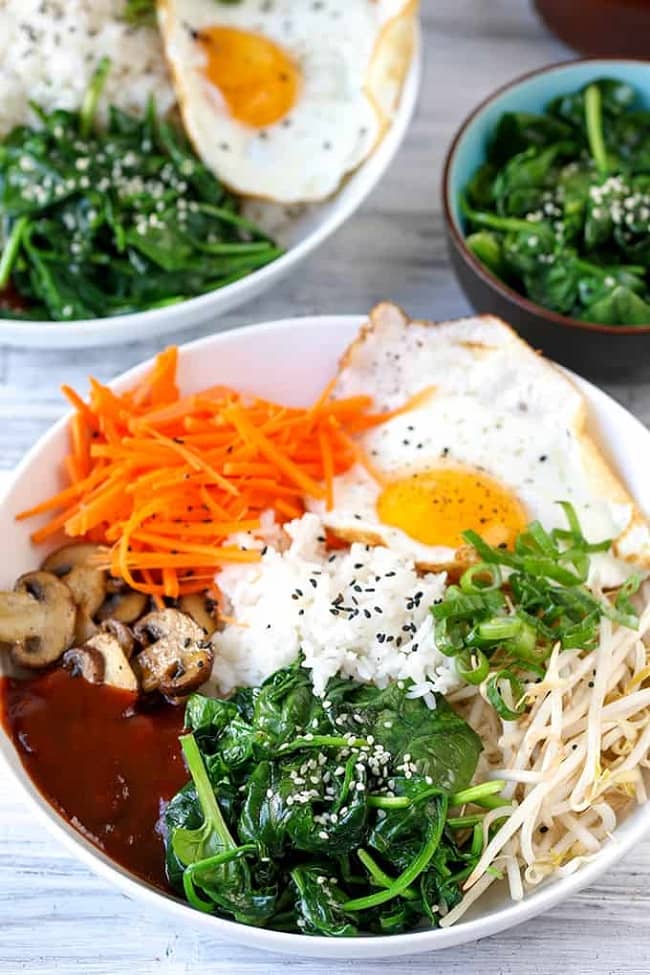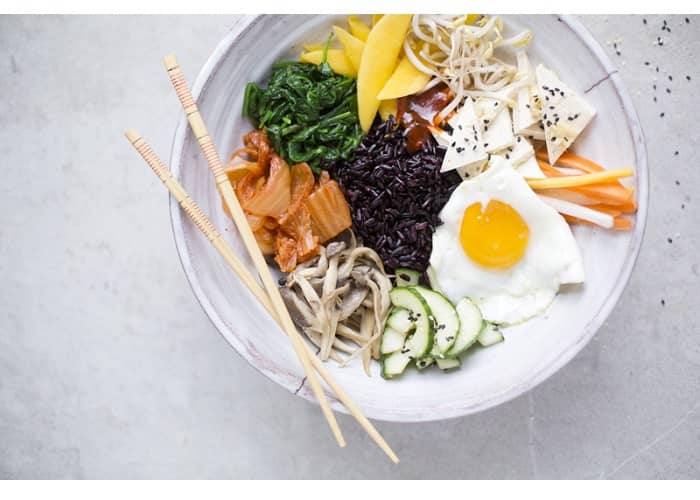- Food: Bibimbap
- Writer: Nicolas Wilson
- Content-Type: Food Blog
This bibimbap recipe is the epitome of bowl food! It’s fresh, healthful, and flavorful, with gochujang sauce and seasoned vegetables on top.
Anyone who tries this bibimbap recipe will fall in love with bowl food. When I say bowl food, I’m referring to any dish that includes a base, such as noodles or rice, protein, vegetables, and a tasty sauce.
I’ve had my fair share of grain and noodle bowls over the years, but bibimbap is without a doubt the pinnacle of bowl eating.
If you’re unfamiliar with bibimbap, it’s a Korean rice bowl topped with a variety of vegetables, spicy gochujang, and an egg or meat. It’s one of the most well-known Korean meals, and you’ll understand why once you have it.
Each ingredient adds something important to the bowl, like richness, heat, or crisp texture.
My bibimbap dish, of course, is meatless, so the vegetables take center stage. Before being placed in the bowl, each one is delicately seasoned to bring out its distinct flavor and texture.
The vegetables provide a true explosion of flavor and texture when combined with heated rice, hot sauce, and a beautifully runny egg. This bibimbap recipe is perfect for you if you enjoy vegetable-forward dishes with a lot of flavors.
Components of the Bibimbap Recipe
The three classic components of my bibimbap recipe are:
- Rice – Bibimbap is often made with white rice, however brown rice or cauliflower rice would also work.
- Break the yolk of a sunny-side-up egg into the bowl to make a sauce-like covering for the rice and vegetables. If you’re vegan, leave out the egg and substitute baked tofu or tempeh instead.
- Gochujang sauce — If there’s one element in bibimbap that stands out, it’s the gochujang sauce. Gochujang paste, a fermented red pepper spread popular in Korean cuisine, gives it a spicy, sweet, and funky flavor.
There’s nothing else quite like it in terms of flavor.
Then I toss in the vegetables! Bibimbap can be made with a broad variety of vegetables, so use whatever you want. Make a simple dish with two or three vegetables, or customize it with your favorite vegetables.
Steamed or sautéed cabbage, bok choy, or daikon all work well in this dish. Can’t decide? This is a terrific combination:
- Cucumber – To give it a tangy, nutty flavor, I thinly slice the cucumber and marinate it in rice vinegar and sesame oil.
- Bean sprouts — These lightly blanched sprouts give this bowl a delightful texture.
- Carrots, shredded — I briefly sauté them in sesame oil to soften them slightly. I use a julienne peeler to cut the carrots, but grated carrots will suffice if you don’t have one.
- Sautéed shiitake mushrooms — Bibimbap can be made with any vegetables, but the mushrooms are my favorite. The umami taste of tamari and rice vinegar is highlighted.
- Sesame oil and tamari give sautéed spinach a toasted, delicious flavor. If you want your bibimbap to be less watery, squeeze the extra liquid out of the spinach after cooking it.
- Gochujang sauce is a Korean condiment.
Bibimbap Preparation and Consumption

To prepare this dish, begin by cooking the rice. While it’s cooking, make the sauce and prepare the vegetables. Begin with the cucumber to let it marinate.
After that, blanch the bean sprouts and cook the carrots, mushrooms, and spinach in a skillet. Cook the eggs last but not least.
Prepare each bowl by layering cooked rice on the bottom and an egg on top. Drizzle the gochujang sauce over the vegetables in portions around the bowl’s perimeter, encircling the egg.
When you’re ready to eat, crack the egg yolk and combine the ingredients. (After all, bibimbap means “mixed rice.”)
The runny egg yolk and sauce will cover the rice and vegetables, making the dish extremely tasty and enjoyable to eat.
I prefer to have extra sauce, sliced green onions, and kimchi on the side of my bibimbap and mix them in as I eat.
You can either leave these ingredients out or add them right away to your bowl. Again, this recipe is adaptable, so make it your own to make a bowl you enjoy!
Bibimbap
A Korean rice bowl loaded with different veggies, gochujang sauce, an egg, and meat is known as bibimbap. My recipe doesn’t use meat, but you won’t miss it. This bowl is bursting with flavor thanks to the seasoned vegetables and sauce!
Ingredients
Bowls
- ½ English cucumber, thinly sliced
- ½ teaspoon rice vinegar
- 1¼ teaspoons sesame oil, divided
- 1 cup fresh mung bean sprouts
- 4 cups of baby spinach
- 1 cup shredded carrots
- ½ teaspoon tamari
- 2 cups cooked short-grain white rice
- 2 fried eggs or 1 cup of cubed baked tofu
- 4 ounces sautéed shiitake mushrooms, optional
- 1 recipe Gochujang sauce
- Sesame seeds
- Sea salt
- Kimchi, optional, for serving
- Chopped scallions, optional, for serving
Instructions

- Toss the cucumber slices with 1/2 teaspoon rice vinegar, 1/4 teaspoon sesame oil, and a sprinkling of salt in a small dish. Remove from the equation.
- A small saucepan of water should be brought to a boil. Cook for 1 minute after adding the bean sprouts. Drain the water and set it aside.
In a medium pan, heat 1/2 teaspoon sesame oil over medium heat. With a touch of salt, toss in the carrots. - Cook for 1 to 2 minutes, stirring occasionally until slightly softened, then remove from the pan and set aside. In the same skillet, heat 1/2 teaspoon sesame oil and add spinach and tamari. Cook for 30 seconds, stirring occasionally, or until the spinach is barely wilted. Remove the spinach from the skillet and squeeze off any extra liquid.
- Arrange the rice, cucumber slices, bean sprouts, carrots, and spinach in the bowls. Serve with a fried egg or baked tofu as a topping. If using, add the mushrooms. Drizzle the gochujang sauce over the top and sprinkle with sesame seeds. If desired, serve with kimchi and scallions on the side, as well as the remaining gochujang sauce.
